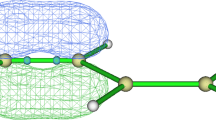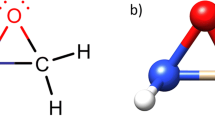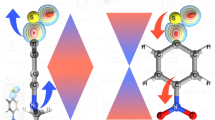Abstract
We explore the behavior of the average of polarizability (< α >), total first hyperpolarizability (βtotal) and average of second hyperpolarizability (< γ >) for single A/D (-NO2/-NH2) substituted [2.2]p-cyclophane. The geometric optimization was carried out at HF and DFT (SVWN, PBE, B3LYP, PBE0, BHHLYP and CAM-B3LYP) level, in gas phase, using the 6-31 + G(d,p) basis set. The static tensor components of < α > and βtotal, in gas phase, were calculated using Field Finite (FF) methods with electric field intensities of E = ± 0.001 a.u. in each (x,y,z) axis direction. The substitution of A/D groups in positions 7–15 (structure 2 in Fig. 1) produced an increment in the < α > values. Regardless of the A/D positions, the < α > values showed not significant changes at all theory level. < α > DFT results are overestimated up to 20%, if HF values are taken into account, being SVWN and PBE functionals those that give the main deviation. There are monotonic and progressive behaviors of βtotal for the 1–5 structure change as expected by orientation of the dipolar moment in both aromatic rings. With respect to the performance of DFT functionals, < γ > and βtotal results are significantly overestimated if HF values are taken into account. In fact, the relative percentage error of βtotal at DFT level with respect to HF ones is between 58 and 132%, being PBE functional those that give the main deviation. The close overlap of the orbitals between the rings facilitates chromophore delocalization to account for the observation of high βtotal in these compounds. Therefore, we expected that the contribution by coupling of the transition moment between first and higher excited states should be lie much higher due to phane effect than that for ring units.

a Single [2.2]p-cyclophane core molecule. b Geometric parameters of interest c Highlights for the 4, 7, 12, and 15 positions, which are substituted by (-NO2/-NH2) acceptor/donor pair



Similar content being viewed by others
References
Adamo, C., Barone, V.: Toward reliable density functional methods without adjustable parameters: the PBE0 model. J. Chem. Phys. 110, 6158–6171 (1999)
Bachrach, S.M.: DFT study of [2.2]-, [3.3]-, and [4.4]paracyclophanes: strain energy, conformations, and rotational barriers. J. Phys. Chem. A. 115, 2396–2401 (2011)
Bartholomew, G.P., Bazan, G.C.: Bichromophoric paracyclophanes: models for interchromophore delocalization. Acc. Chem. Res. 34, 30–39 (2001)
Bartholomew, G.P., Ledoux, I., Mukamel, S., Bazan, G.C., Zyss, J.: Three-dimensional nonlinear optical chromophores based on through-space delocalization. J. Am. Chem. Soc. 124, 13480–13485 (2002)
Bartholomew, G.P., Rumi, M., Pond, S.J.K., Perry, J.W., Tretiak, S., Bazan, G.C.: Two-photon absorption in three-dimensional chromophores based on [2.2]-paracyclophane. J. Am. Chem. Soc. 126, 11529–11542 (2004)
Bazan, G.C.: Novel organic materials through control of multichromophore interactions. J. Org. Chem. 72, 8615–8635 (2007)
Bazan, G.C., Oldham, W.J., Lachicotte, R.J., Tretiak, S., Chernyak, V., Mukamel, S.: Stilbenoid dimers: dissection of a paracyclophane chromophore. J. Am. Chem. Soc. 120, 9188–9204 (1998)
Becke, A.D.: Density-functional thermochemistry. III. The role of exact Exchange. J. Chem. Phys. 98, 5648–5653 (1993)
Brédas, J., Adant, C., Tackx, P., Persoons, A.: Third-order nonlinear optical response in organic materials: theoretical and experimental aspects. Chem. Rev. 94, 243–278 (1994)
Chang, Y.J., Chow, T.J.: Dye-sensitized solar cell utilizing organic dyads containing triarylene conjugates. Tetrahedron 65, 4726–4734 (2009)
Chang, Y.J., Watanabe, M., Chou, P.T., Chow, T.J.: [2.2]Paracyclophane as a bridging unit in the design of organic dyes for sensitized solar cells. Chem. Commun. 48, 726–729 (2012)
Elacqua, E., MacGillivray, L.R.: From the decks to the bridges: optoelectronics in [2.2]paracyclophane chemistry. Eur. J. Org. Chem. 2010, 6883–6894 (2010)
Ernzerhof, M., Scuseria, G.E.: Assessment of the Perdew–Burke–Ernzerhof exchange-correlation functional. J. Chem. Phys. 110, 5029–5037 (1999)
Ferrighi, L., Frediani, L., Fossgaard, S., Ruud, K.: Two-photon absorption of [2.2]paracyclophane derivatives in solution: A theoretical investigation. J. Chem. Phys. 127, 244103 (2007)
Forrest, S., Thompsom, M.: Introduction: organic electronics and optoelectronics. Chem. Rev. 107, 923–925 (2007)
Gibson, S.E., Knight, J.D.: 2.2]Paracyclophane derivatives in asymmetric catalysis. Org. Biomol. Chem. 1, 1256–1269 (2003)
Grimme, S.: On the importance of electron correlation effects for the π–π interactions in cyclophanes. Chem. Eur. J. 10, 3423–3429 (2004)
Hahn, S., Kim, D., Cho, M.: Nonlinear optical properties of the linear quadrupolar molecule:structure−function relationship based on a three-state model. J. Phys. Chem. 103, 8221–8229 (1999)
Hong, J.W., Benmansour, H., Bazan, G.C.: Through-space delocalized water-soluble paracyclophane bichromophores: new fluorescent optical reporters. Chem. Eur. J. 9, 3186–3192 (2003)
Hope, H., Bernstein, J., Trueblood, K.N.: The crystal and molecular structure of 1,1,2,2,9,9,10,10-octafluoro-[2,2]paracyclophane and a reinvestigation of the structure of [2,2]paracyclophane. Acta Crystallogr. Sect. B 28, 1733–1743 (1972)
Kamada, K., Ueda, M., Nagao, H., Tawa, K., Sugino, T., Shmizu, Y., Ohta, K.: Molecular design for organic nonlinear optics: polarizability and hyperpolarizabilities of furan homologues investigated by ab initio molecular orbital method. J. Phys. Chem. A 104, 4723–4734 (2000)
Kurtz, H.A., Stewart, J.J.P., Dieter, K.M.: Calculation of the nonlinear optical properties of molecules. J. Comput. Chem. 11, 82–87 (1990)
Lee, Jin Yong: Collective electronic oscillator method: application to conjugated organic molecules. Bull. Korean Chem. Soc. 24, 780–784 (2003)
Lee, C.T., Yang, R.G., Parr, R.G.: Development of the Colle-Salvetti correlation-energy formula into a functional of the electron density. Phys. Rev. 37, 785–789 (1988)
Lee, W.-H., Lee, H., Kim, J.-A., Choi, J.-H., Cho, M., Jeon, S.-J., Cho, B.R.: Two-photon absorption and nonlinear optical properties of octupolar molecules. J. Am. Chem. Soc. 123, 10658–10667 (2001)
Leung, M.-K., Viswanath, M.V., Chou, P.-T., Pu, S.-C., Lin, H.-C., Jin, B.-Y.: The phane properties of anti-[2.2](1,4)biphenylenophane. J. Org. Chem. 70, 3560–3568 (2005)
Liu, Y.F., Ren, X.F., Zou, L.Y., Ren, A.M., Feng, J.K., Sun, C.C.: Theoretical study on photophysical properties of 2,1,3 benzothiadiazole-based star-shaped molecules. Theor. Chem. Acc. 129, 833–845 (2011)
Marcano, E., Squitieri, E., Murgich, J., Soscún, H.: Theoretical investigation of the static (dynamic) polarizability and second hyperpolarizability of DAAD quadrupolar push–pull molecules. A comparison among HF (TD-HF), DFT (TD-B3LYP), and MP2 (TD-MP2) methods. Comput. Theor. Chem. 985, 72–79 (2012)
Maroulis, G.: On the accurate theoretical determination of the static hyperpolarizability of trans-butadiene. J. Chem. Phys. 111, 583 (1999)
Moorthy, J.N., Mandal, S., Kumar, A.: Photochromism of novel chromenes constrained to be part of [2.2]paracyclophane: remarkable ‘phane’ effects on the colored o-quinonoid intermediates. New J. Chem. 37, 82–88 (2013)
Morisaki, Y., Chujo, Y.: Synthesis of π-stacked polymers on the basis of [2.2]paracyclophane. Bull. Chem. Soc. Jpn. 82, 1070–1082 (2009)
Nalwa, H.S., Miyata, S.: Nonlinear Optics of Organic Molecules and Polymers. CRC Press, New York (1997)
Parr, R.G., Yang, W.: Density Functional Theory of Atoms and Molecules. Oxford University Press, Oxford (1989)
Pathenopoulos, D.A., Rentzepis, P.M.: Three-dimensional optical storage memory. Science 245, 843–845 (1989)
Perdew, J.P., Burke, K., Ernzerhof, M.: Generalized gradient approximation made simple. Phys. Rev. Lett. 77, 3865 (1996)
Sahraoui, B., Rivoire, G.: Degenerate four-wave mixing in absorbing isotropic media. Optics Communications. 138, 109–112 (1997)
Sahraoui, B., Nguyen Phu, X., Sallé, M., Gorgues, A.: Electronic and nuclear contributions to the third-order nonlinear optical susceptibilities of new p-N, N′-dimethylaniline tetrathiafulvalene derivatives. Opt. Lett. 23, 1811–1813 (1998a)
Sahraoui, B., Rivoire, G., Terkia-Derdra, N., Sallé, M., Zaremba, J.: Third-order nonlinear optical properties of new bisdithiafulvenyl-substituted tetrathiafulvalene. J. Opt. Soc. Am. B 15, 923–928 (1998b)
Shelton, D.P., Rice, J.E.: Measurements and calculations of the hyperpolarizabilities of atoms and small molecules in the gas phase. Chem. Rev. 94, 3–29 (1994)
Shirai, S., Iwata, S., Maegawa, Y., Tani, T., Inagaki, S.: Ab initio molecular orbital study on the excited states of [2.2]-, [3.3]-, and siloxane-bridged paracyclophanes. J. Phys. Chem. A 116, 10194–10202 (2012)
Slater, J.C.: A simplification of the Hartree-Fock method. Phys. Rev. 81, 385–390 (1951)
Squitieri, E.: Contributions of anharmonics to the nuclear relaxation second hyperpolarizability of a push–pull polyene. J. Phys. Org. Chem. 17, 131–137 (2004)
Stephens, P.J., Devlin, F.J., Chabalowski, C.F., Frisch, M.J.: Ab initio calculation of vibrational absorption and circular dichroism spectra using density functional force fields. J. Phys. Chem. 98, 11623–11627 (1994)
Tu, Y., Luo, Y., Agren, H.: Molecular dynamics simulations applied to electric field induced second harmonic generation in dipolar chromophore solutions. J. Phys. Chem. B 110, 8971–8977 (2006)
Vosco, S.H., Wilk, J., Nusair, M.: Accurate spin-dependent electron liquid correlation energies for local spin density calculations: a critical analysis. Can. J. Phys. 58, 1200–1211 (1980)
Yanai, T., Tew, D., Handy, N.: A new hybrid exchange–correlation functional using the Coulomb-attenuating method (CAM-B3LYP). Chem. Phys. Lett. 393, 51–57 (2004)
Zhao, Y., Truhlar, D.G.: A density functional that accounts for medium-range correlation energies in organic chemistry. Org. Lett. 8, 5753–5755 (2006)
Zhao, Y., Truhlar, D.G.: The M06 suite of density functionals for main group thermochemistry, thermochemical kinetics, noncovalent interactions, excited states, and transition elements: two new functionals and systematic testing of four M06-class functionals and 12 other functional. Theor. Chem. Acc. 120, 215–241 (2008)
Zhou, W., Kuebler, S.M., Braun, K.L., Yu, T., Cammack, J.K., Ober, C.K., Marder, S.R.: An efficient two-photon-generated photoacid applied to positive-tone 3D microfabrication. Science 296, 1106–1109 (2002)
Zyss, J., Ledoux, I., Volkov, S., Chernyak, V., Mukamel, S., Bartholomew, G.P., Bazan, G.C.: Through-space charge transfer and nonlinear optical properties of substituted paracyclophane. J. Am. Chem. Soc. 122, 11956–11962 (2000)
Acknowledgements
We acknowledge support by Fondo Nacional de Ciencia, Tecnología e Innovación (FONACIT) through grant PEI-1852 and Centro de Investigaciones en Ciencias Naturales (CICNAT) through project N° 12-073.
Author information
Authors and Affiliations
Corresponding author
Rights and permissions
About this article
Cite this article
Marcano, E., Alayón, J. & Cisneros, J.G. Static (hyper)polarizabilities and absorption spectra of single [2.2]p-cyclophane NO2/NH2 substituted from DFT methods. Opt Quant Electron 49, 189 (2017). https://doi.org/10.1007/s11082-017-1023-6
Received:
Accepted:
Published:
DOI: https://doi.org/10.1007/s11082-017-1023-6




